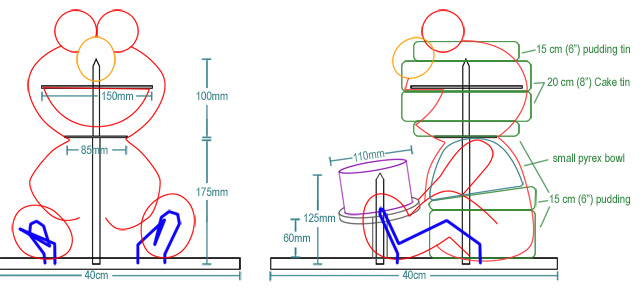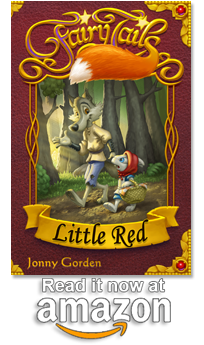In How I Made an Elmo Cake… Part 1 I talked about planning the cake, making the stand and making the icing. In this installment I’ll cover making and carving the cakes. Following that will be making and molding the rice crispy arms, legs, eyes and nose, creating the blocks and piping the fur.
Making The Cakes
As I mentioned last time, when planning the cake I set the size by using existing tins for the body, a pudding tin and a small pyrex bowl. These work well together as the rim of the bowl is the same diameter as the pudding tin. I used the same combination for the head of Serenity’s Dorothy the Dinosaur cake. Going from there it was just a matter of seeing what tin sizes would best fit the head.
 As you can see from the plan above, I ended up using a pudding tin, 1/3 of a pudding tin (cut into a wedge), and a pyrex bowl for the body. I used two 20cm cake tins for the head with 1/3 of a pudding tin on top and below. I used two 9cm (3 1/2″) cakes for the smash cake. So I would need:
As you can see from the plan above, I ended up using a pudding tin, 1/3 of a pudding tin (cut into a wedge), and a pyrex bowl for the body. I used two 20cm cake tins for the head with 1/3 of a pudding tin on top and below. I used two 9cm (3 1/2″) cakes for the smash cake. So I would need:
- 2 x 20cm cakes
- 2 x 15cm (7.5cm or 3″ deep) cakes – pudding tin
- 1 x pyrex bowl
- 2 x 9cm cakes
Although the pudding tins are smaller in diameter, they’re deeper so they tend to use about the same amount of cake mix as a 20cm cake, and the pyrex bowl uses about 2/3 of a mixture. So I ended up making 5 batches. The left over batter from the pyrex bowl was enough for the 9cm cakes.
If you don’t have a small pyrex bowl you could also use a Dolly Varden tin, or another pudding tin if you carve the top of the resulting cake so it’s rounded. If you don’t have a pudding tin, or 15cm cake tin, you could also use 20cm cakes and carve them into shape. You would need 4 x 20cm cakes to make up the height of the body, and 3 for the head, so you’d end up needing at least 7 batches. So you can see using shaped tins not only means less work in carving, but less wasted cake (Not that the cake is ever wasted, between taste testing and cake balls) and less money spent on ingredients.
I had some leftover cake that I used to make the present and blocks, but if you want to make them out of cake (you can also make them out of rice crispies) you’ll need to make enough cake for those too. When we get into the blocks in detail I’ll give you the dimensions and some idea of how much cake you’ll need for those.
Freezing the cake
Freezing the cake makes it much easier to carve, and seems to keep in the moisture. I’ve had really good results from freezing the cake, people often remark on how moist and nice the cake is, even after a few days. Elmo was in the freezer, with the crumb coat done but only wrapped loosely, for 5-6 weeks alongside half a sheep and a big snapper. I thought the cake would be dry and not too good after that, but my sister recently told me how tasty and moist the the cake ended up. It all ended up being eaten which was a very nice surprise. After all, it’s no use making a pretty cake if it doesn’t taste good.
Once the cakes are baked and cooled, we’ll freeze them before carving. But first (after making sure they’re well cooled) cut the domed tops off them (called leveling), and put aside one of the pudding (15cm) cakes. Now here’s the tricky bit. I like to make a hole for the dowel, before the cakes are frozen, with a thin knife (a steak knife works well). It’s much easier to make the hole in freshly made cake than frozen cake. The tricky part of this is knowing where to put the hole. For the head it’s pretty straight forward, right in the middle. For the body it’s a bit trickier. Work it out from the plans where the dowel goes in the bottom and where it comes out the top, sometimes at an angle. From there make a hole in the bottom roughly heading towards the right place, and then a hole at the top heading towards the hole at the bottom. From there push the knife through each side until it comes through the hole in the other side. It doesn’t have to be a very wide hole, just enough that you can push the dowel through when the cake is frozen.
Once all the holes are in place, cut the thicker cakes into 2 or 3 layers (called torting). Take the pudding cake that was put aside and cut it into thirds. Put a hole through the middle of the two outer layers, and towards one edge of the middle layer (using the other pudding cake as a guide for the position of the hole). If the cake is firm enough, you can cut this middle layer into a wedge now, otherwise it might be easier to do it when it’s frozen.
Once all that’s done, double wrap each cake in plastic wrap and put them in the freezer for a few hours, or overnight.
Planning Your Time
Speaking of which, I just realized I forgot to mention in the planning stage about planning your time. Making these cakes isn’t a quick process, and you need to allow yourself enough time to make the cake, but not so much time that the finished cake is sitting around for too long before the party.
Now I don’t know how professional cake decorators do it, I’m sure being able to make all the cakes at once, having lots of fridge and freezer space and large quantities of icing makes the process much quicker and easier. I don’t have big enough bowls, enough cake pans or enough space in my oven to make all the cakes at the same time, and invariably need to re-arrange everything in the freezer just to squeeze cakes in. So here’s a plan I would use for this cake:
- Day 1
- Make the stand
- Make fur icing
- Make cakes
- Make fondant
- Make crumb coat icing
- Carve cake
- Crumb coat
- Rice crispies
- Make eyes, nose, and start on blocks
- Decorate smash cake
- Fur icing
- Put eyes and nose on
- Finish blocks and toys
- Party!!
Day 2
Day 3
Day 4
Day 5
This ensures that the actual cake stays frozen as long as possible throughout the process, and is thawed as close to the day of the party as possible. In this case only one day before, at which point it’s well sealed by the icing and will stay nice and fresh.
I usually make the butter cream icing the day of carving the cake, but in this case it’s worth making a few days before making the stand to let the color set in.
Carving the Cake
Ooh it’s exciting. This is one of the most fun parts of making these cakes. It’s also one of the most stressful, as you can so easily go wrong. I always have in the back of my mind that I may need to make the cakes all over again if I stuff it up and that’s where the stress comes from because as you can see from my timeline above, I rarely leave enough time to start again (without losing massive amounts of sleep).
So we need to start by making a few batches of icing to fill the cakes and provide the crumb coat. When icing a cake, it’s always a good idea to give it a crumb coat. A crumb coat serves a number of purposes. Firstly as it’s name suggests, it traps the crumbs so that if your covering the cake in butter cream icing, you don’t get crumbs all through it. For carved cakes, it seals the cake for when it’s put back in the freezer, so you don’t need to wrap it again to retain the moisture, and it also lets you smooth the surface of the cake, forgiving errors in your carving and building up areas that need it. For fondant covered cakes, it gives the fondant something to stick to so the fondant adheres to the cake well and doesn’t just slide off, and smooths the surface of the cake so you don’t have lumpy fondant.
Cream Cheese Frosting
Beat 125g softened butter, 250g softened cream cheese, and 1 tsp vanilla extract for 3 mins or until light and fluffy. Gradually add 4 cups (640g) of sifted icing sugar, beating until incorporated. Refrigerate for 1 hour.
Thanks to Bakerella I’ve just recently discovered cream cheese frosting/icing, which tastes just like cheese cake, and is delicious with chocolate cake. I’d recommend cream cheese icing to fill between each layer of cake, just because it’s so yummy. I would make chocolate icing for the crumb coat, maybe with some red coloring. The reason for this, other than it tastes nice, is that a darker crumb coat or undercoat is preferable so that any gaps in the fur coat look ok. If a lighter color was underneath, gaps would be very obvious and look a bit strange.
The great thing about the filling and crumb coat is you don’t have to make too much icing to start with, as if you underestimate, you can just make more. It’s not always as easy to do this with the top coat, especially because of color matching.
So you’ve got some icing ready, and your stand on the bench. It’s crunch time. Grab the cakes from the freezer. If you’ve got the disk and thinner dowel on the main dowel, take them and the wire off and place a small piece of plastic wrap over the top of the dowel, protecting the hole from crumbs.
Unwrap the pudding cake and push each layer down over the dowel, using the pre-made hole in the cakes as a guide for positioning. Put a nice thick layer of filling over the top of each layer before putting the next layer on.
Why the Wedge?
If you look at the plan, you can see the wedge of cake makes Elmo sit a bit forwards rather than sitting straight up. This is a more natural pose, so makes the cake look less like a cake and more like a character. It also allows the body to be further back, leaving more room for the smash cake without Elmo’s arms being absurdly long.
If you have already cut the middle pudding layer into a wedge, push this down over the dowel. Otherwise cut the wedge out and then push it down. Put a layer of filling on and then push the pyrex bowl layers over the dowel, making sure to sandwich a nice thick layer of filling between every layer. The top of the cake at this stage should be roughly level with the top of the dowel. If it’s a bit higher you can push down the layers a bit, or cut a bit off the top. If it’s a bit lower that’s ok too, you can build it up a bit with icing.
Now you can do some cutting. Carve the wedge to follow the contours established by the other cakes. You can then smooth all the edges so there’s a nice smooth transition between all the layers. There may be some gaps in the edges between the layers, but that’s ok, they’ll be filled with icing in a minute. Now grab a spatula or butter knife and start spreading the crumb coat icing over the surface. Fill in the gaps between cakes and make sure there’s a nice smooth surface over the whole thing. You’ll notice that, because the cakes are frozen, the icing hardens almost as soon as you put it on. This makes it even easier to get a smooth surface. It doesn’t have to be super smooth, just with the major gaps filled really, and a nice thin coating of icing over the whole thing.
Now take the plastic wrap off the dowel and put the wire, disk and thinner dowel on ready to support the head.
Put on the bottom layer of the pudding, cover with filling, then place on one of the 20cm cakes. Put a thin layer of filling on top then place on the large disk (You could make this out of cardboard, but because there’s a fairly large amount of cake being suspended I chose to use MDF just to be sure.) Another layer of filling on the disk and then the other 20cm cake, filling and finally the last layer of pudding cake.
Start carving the head into a spherical shape. Once that’s done, give the head a crumb coat taking extra care with the top back and sides.
To make the mouth, start at the top edge of the bottom layer of the head, cut upwards, making a wedge in the front up to the disk in the middle. Start smaller than you need, because you can always cut more away. If the mouth is too small, cut more, perhaps starting a bit lower if you want a more open mouth, or just deeper for a wider mouth. Once that’s done, crumb coat the inside of the mouth, making sure the disk is hidden and smoothed by icing.
And that’s the carving done. Looking at the cake as a whole, if you need to cut any more away, or build any areas up with icing, you can do it now. Check that the mini cake board for the smash cake fits over the front dowel. If the tummy gets in the way you can cut a bit more away there until the mini cake board goes on easily. Finally put the whole thing in the freezer to freeze back up before we add the rice crispies.
If you don’t have a freezer big enough to hold the cake board with the stacked cake on it, then you may need to arrange your time a little differently. I’ll talk more about that at the end.
I’m afraid that’s all I have time for in this installment. We’ll get onto the rice crispies next time…
As always, if you have any comments or questions please feel free to leave them below and I’ll answer them directly or in the next installment.
Continue to How I Made an Elmo Cake… Part 3…





